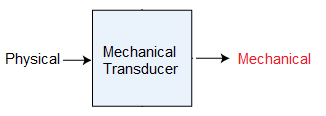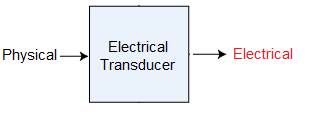TransducersA transducer is an electronic device that converts one form of energy (non-electrical) to another form of energy (electrical). The process of conversion of one form to another is known as transduction. Thus, we can define a transducer as a device that converts non-electrical energy to electrical energy. It is a part of every communication system that transmits information from the sender to the receiver. The information is always transmitted and processed in the electrical form inside any communication system. Hence, a transducer is essential because it converts any form of energy to the electrical form, making the data suitable for transmission. Transducers are often used at the boundaries in control systems, automation, etc., where electrical signals are generated from various physical quantities, such as force, motion, pressure, energy, and position. A transducer is essential for any device because it makes the signal a suitable form of transmission. Otherwise, the signal cannot be transmitted for measurement. Let's discuss the concept of using transducers in some of the common electronic devices. SpeakerSpeaker is a device that takes the voice input from the user and produces the same voice with greater frequency. It means that the voice at the output of the speaker is louder. A speaker has various components, such as transducer at the input and output, modulators, and filters. The transducers at both the ends convert sound energy into the electrical energy and vice-versa. We can also say that the transducer at the output extracts the sound signal from the electrical signal. The increase in the frequency of the signal is termed as modulation and is performed by the combination of modulators and filters. The function of filter is to remove any noise or attenuation. Electric motorThe movement of the motor is a type of mechanical motion. The electrical motor runs through the electricity. The transducer at the input converts the electrical energy from the power supply to the mechanical energy, which is required to run the motor. Light BulbA light bulb is also a device that works with the help of transducers. A transducer in the bulb converts the electrical energy from the power supply to the optical energy, which illuminates the bulb in the form of light. We will discuss about the various applications of transducers later in the topic. Types of TransducersTransducers are classified based on different categories.
Based on the requirement at boundariesA transducer is required at both the transmitting and receiving end. There are two types of transducers that are used at the boundaries, input transducer and output transducers. Input Transducers The transducer required at the transmitting end is known as input transducer. It is present at the beginning of an electronic device. It always converts the input signal into the suitable form of transmission that can easily flow through the device. For example, The input transducer of the speaker converts the sound energy into the electrical energy. Output Transducers The transducer required at the receiving end is known as output transducer. It is present at the end of an electronic device. It always converts the received signal into its original form. For example, The output transducer of the speaker converts the electrical energy back into the sound energy, which appears with greater frequency at the output. Based on the physical quantitiesThe types of transducers based on the physical quantities are classified as, mechanical transducers and electrical transducers. Mechanical transducers The transducers that convert the physical quantities to the other form of quantities (mechanical) are known as mechanical transducers. It is a mechanical element that produces the output in the form of mechanical energy. 
For example, Bimetallic strip It responds to the changes in the environment and produces the output as a mechanical displacement. Electrical transducers The transducers that convert the physical quantities to the other form of quantities (electrical) are known as electrical transducers. 
For example, Microphone It converts the sound energy as the input from the user and transmits it to the other user in the form of electrical signal. Based on the componentsThe types of transducers based on the components are classified as, active transducers and passive transducers. Active Transducers Active transducers are the device that requires external power source to convert one form of energy to the other. For example, Thermistor It cannot generate an electrical signal until the electric current is applied. The variations in current or voltage in thermistor helps to measure its resistance, which changes with the temperature. It is a device known to measure the temperature. Passive Transducers Passive transducers are the device that does not require any external power source to convert one form of energy to the other. For example, Photodiode It converts the light (in the form photons) to an electrical current. The photons present in the light provide energy to the p-n junction semiconductor, which helps in generating an electric current. Block diagram of a transducerBlock diagram refers to the visual representation using simple blocks arranged in cascade or parallel depending on the functionalities. The connected line between the two blocks depicts the relationship between them. The block diagram of a transducer is shown below: 
It consists of a sensor and a transduction element connected in series. The sensor acts as a sensing element and detects the changes in the environment. According to the changes, the transduction element performs the conversion from one form to the other. The input to the sensing element is a non-electrical quantity, while the output of the transduction element is an element quantity. The input and output can also vary depending on the type of transducers. It is also known as the input transducer. A transducer as an output transducer works in an opposite way. It converts the electrical quantity to the non-electrical quantity or the original form of transmission. It is done to provide the original signal at the output. Efficiency of TransducersEfficiency is defined as the ratio of output power to the input power. The efficiency of transducers is given by: E = O/I Where, E is the efficiency O is the output power I is the input power No transducer is fully efficient. Some power loss always occurs during the conversion process. The power loss is generally dissipated in the form of heat. Incandescent bulbs have higher heat dissipation than other light sources, such as LEDs. Hence, LEDs have wide applications due to their good transduction ability and low heat dissipation. Sensors vs. transducersSensor is a device that responds to the changes in the environment as the output. The sensors and transducers are often used in various electronic devices and are often creates confusion. Both the devices convert the energy using physical quantities from the environment into the readable form. Let's discuss the differences between these two devices. The differences between a sensor and transducers are listed in the below table:
Advantages of TransducersThe advantages of Transducers are as follows:
Disadvantages of TransducersThe disadvantages of Transducers are as follows:
Applications of TransducersTransducers are present in every device that requires the energy conversion from one form to the other. There are various applications of transducers. Let's discuss some of its most common applications.
Note: Antenna is a major part of a radio transmitter and a radio receiver.
Next TopicMultiplexing
|
 For Videos Join Our Youtube Channel: Join Now
For Videos Join Our Youtube Channel: Join Now
Feedback
- Send your Feedback to [email protected]
Help Others, Please Share










